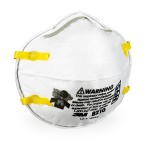I once purchased an investment property that I was sure was going to be an ideal rental house. It was in a location where there was high demand for rentals, and it was nice attractive house.
My Shocking Experience
I decided to check out the property one more time on the day before signing the papers. I was in for a shock. When I opened the door, I was hit in the face with an overpowering dank smell that was so thick that I almost couldn’t get into the house. It was like walking underwater.
I looked down and I saw that the carpets were soaked with water. The walls of the house were black. I quickly discovered that the hot water heater was leaking, and had flooded the house.
Since all the windows and doors tightly closed, the mother-of-all steam baths had formed inside the house. If I weren’t already as thin as a rail, I probably could have lost 30 pounds in there in 10 minutes.
I Feel a Scream Coming
While I would have had every right to scream like Jamie Lee Curtis in those old “Halloween” movies, to my credit, I didn’t do that. Plus, my two sons were with me at the time, and it would have ruined the image they had of me as a modern-day James T. Kirk, bold captain of the Sprouse family.
Since I’ve now used up my ‘reservoir’ of metaphors to describe this dire situation, let’s get to the steps to address this issue.
5 Steps to Take if Your House is Flooded
1.) Don’t touch the merchandise.
Don’t touch anything that is electric while standing in water. It may be tempting to want to turn on lights and turn off appliances, but don’t do it. You wouldn’t adjust the radio while you are in a bathtub, and your house is now a giant bathtub. If the electrical outlets near the floor are saturated, you should not be in that house.
If the fuse box is in a dry location, turn off the power.
Have an electrician check the system before turning on the power again.
If you plan to be inside the house for any amount time, or if you plan to clean up mold, you should wear a N95 mask to wear while you’re there. (See step #5 before donning your mask).
2.) Remove the water.
Open up the doors and windows and let the house air out for at least 30 minutes before spending any time in the house.
Dry out things that got wet. You basically have between 24 to 48 hours to dry out things that have gotten wet, before irreparable damage sets in.
Once the electricity is back on, having been checked by an electrician, you can use a “wet dry” shop vacuum to remove standing water. Wear rubber boots.
Even after the water is pumped out of the house, you must act quickly to avoid the residual damage in walls and under carpets. The imbedded dampness can permanently weaken carpet fibers and soften sheetrock walls.
The most important thing to worry about is mold and mildew. Mold and mildew spores are always present in the air that we breathe and if we only add a little warmth, darkness, and moisture, they become unwelcome house guests.
3.) Get the humid air out.
Use de-humidifiers and fans to remove the excess humidity. Place fans in doors and windows to blow the air out the window, so as not to circulate mold back into the house.
Do not turn the furnace on to dry out the air. This will only increase the humidity and transport the spores throughout the house.
Have your home heating, ventilating, and air-conditioning (HVAC) system checked and cleaned by a maintenance or service professional who is experienced in mold clean-up before you turn it on.
4.) Get rid of carpet padding.
Usually, even though you haven’t passed the 24-48 hour time limit, disaster recovery experts will remove any soaked padding from beneath the carpet and treat the floor and the underside of the carpet with a mildew inhibitor such as Pine Sol.
5. Let the doctors do their job
The Nexium commercial (to treat heartburn) says, “You wouldn’t want a doctor doing your job,” and a doctor comes trotting out of the bullpen to be the relief pitcher in a professional baseball game, or operates a jack hammer. This principal applies to you and your flooded house too. Unless you are an expert, you probably shouldn’t tackle this project yourself. Because mold and mildew are such dangerous foes, it’s best to call in the pros to handle flooded houses.
The Happy Conclusion to My Story
In the case of the investment property that I mentioned earlier, the water had been in the house for several days (beyond the 24-48 hour limit) and the owner wisely owner hired a mitigation company. The company had to replace all of the carpeting and most of the drywall. It was almost like a new house when they finished. They tested the air and the spore count for mold and mildew in the house, and when they were finished, the count was lower than the count outside the house.
Although I had cancelled the sale, I made another offer on the house when it came back on the market, and I wound up purchasing the property after all. It was a better house than the first time I bid on it.
Below is a useful video series about dealing with flooded houses. The emphasis is on pretty drastic flooding (way over the 24-48 hours limit), but it covers many important things to consider.
Related Articles
6 Steps to Roof Maintenance (for the Home that will Turn Into a Rental House)
How I Evicted A Problem Tenant in 4 Steps
When to Hire a House Inspector – Radio Interview with Rich Peterson
Getting Rid of Bad Tenants
“Turn your home into a rental” on Mark Wayne Show
7 Reasons to Live in a Fixer-Upper House While You Repair It
6 Steps to Roof Maintenance (for the Home that will Turn Into a Rental House)
Our First Rental House Plunge
10 Most Frequent Problems Found by House Inspectors
5 Steps to Get Your House Ready to Rent by Terry Sprouse
Some perfectly legal ways to maximize your rental profits
Add “Start a Rental House Business” to Your Bucket List
The 5 Rules on How to Lose Money and Get Your Rental Property Trashed by Tenants
Window Repair with #2 Son
Required Roof Maintenance for Fixer Upper Houses
Learn to Repair Your Fixer Upper Houses
How I Got Started In Fixer-Upper Houses
How to learn to operate a fixer upper house business
The Peaceful Warrior and Fixer-Upper Houses
Tags: Captain James T.Kirk, flooded house, flooding house, Halloween, house flood, house in a flood, house repair, investment property, Jamie Lee Curtis, mold in house, N 95 mask, what to do if your house is flooded




Reacting in a safe manner when you have a flood, sounds like a perfect way to keep out of harms way. Knowing the dangers of touching electrical features when there is water present, I would agree can keep you safe. Understanding the process of drying out your wet carpet, will be helpful. I wouldn’t want mold to develop.
Hi Terry,
Thanx for sharing such an awesome post. I really loved it, it’s so scary – every time you turn around it’s something new – toxins, poisons, dangerous toys, recalls, deadly cribs… it can be very overwhelming. Thank you for an informative post that didn’t send me into full-scale panic.
And According to me it’s better to hire the services of professional company and take preventive measures so that mold and mildew problem does not accumulate further.
Hi Bud,
I really appreciate this post.
Actually, if we ignore the problem then it will result into a disaster. I think one of the hardest things to do is pull out mold, mildew and gunk from in between the tiles in the bathroom.
I found black mould in my bathroom today and I’ve been doing a ton of research. I didn’t know if it was safe to remove myself or if I should hire professionals. Then I hired mold removal company and now I feel free.
Regards
ThatmoldLady
Thanks so much for sharing this post! I think it is so important to know the steps you can take to both prevent a disaster as well as knowing just how to prepare yourself in case anything occurs. Thanks again for writing and sharing your tips!
Larissa,
You’re welcome. Thank you for the comment.
Our home was recently flooded and after that flood cleaning up was a long and hard process! We Shovel out as much mud as possible, then used a garden sprayer and a hose to wash away mud from the hard surfaces.
[…] is at What I’m Reading: Grey Skies, Terry also included some good information on 5 Steps To Take If Your House Is Flooded, and here are Catherine’s Weekly […]